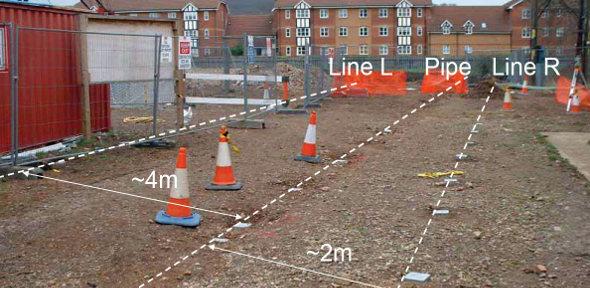
One of the challenges facing engineers in the 21st century is the maintenance, upgrading and safe operation of ageing infrastructure.
Most high profile civil engineering projects specify the use of extensive monitoring systems to observe the influence of new construction on existing infrastructure. The successful evaluation of the effects of construction and also the long-term behaviour of infrastructure hinges on the availability and quality of appropriate measurements. The aim of a new project being conducted here in the Department of Engineering, funded by the Cambridge MIT Institute, is to contribute to the development of Smart Infrastructure by the commercialisation of an innovative but proven low cost fibre optic sensing system enabling continuous strain measurement by means of Brillouin Optical Time-Domain Reflectometry (BOTDR).
The critical deterioration of civil infrastructure has driven the search for new methods of rehabilitation and repair by incorporating sensors and developing remote systems that would allow monitoring and diagnosis of possible problems occurring. In the context of underground infrastructure, such as tunnels and pipelines, it is envisaged that structures will eventually be able to monitor themselves and inform owners of their state (Smart Infrastructure). Design limits are frequently based on strain developing in the structure. Although strain measurement is well established, current practice has until recently been restricted to measurement of point strains only by means of vibrating wire (VWSG) or metal foil strain gauges and more recently fibre optics utilising Fibre Bragg Grating (FBG) technology. When instrumenting building components, such as columns or beams where the strain distribution is merely a function of the end conditions and applied loading, point sensors are suitable to define the complete strain profile. However, where structures interact with soil, (e.g. underground infrastructure such as foundations, tunnels or pipelines) or indeed in the case of a soil structure (road or dam embankments), the state of the structure is not fully understood unless the complete in situ strain regime is known. In the context of monitoring strain in piled foundations, tunnels, pipelines, slopes or embankments, capturing the continuous strain profile is often invaluable to pinpoint localised problem areas such as joint rotations, deformations and non-uniformly distributed soil-structure interaction loads.
BOTDR offers very exciting possibilities for major advances in strain measurement. The novelty of the technology is vested in the ability to measure strain along the full length (up to 10km) of a suitably installed optical fibre. When the fibre is strained, some of the light travelling down the optical fibre is scattered back to the source. In the case of Brillouin scattering, the frequency of the backscattered light is shifted by an amount proportional to the strain at the scattering location, which upon analysis provides the complete strain profile along the full length of the fibre (readings at minimum 50 mm spacing). This is a major advantage over conventional 'point sensing' techniques. For extensive application to develop 'smart infrastructure', in which strain measurement becomes more routine than at present, cost is particularly important. The cost of a standard optical fibre is very low (from £0.1/m) compared to other point measurement sensors and can be employed over distances of several kilometres using a single continuous fibre. Most of the capital investment relates to the analyser (£68k), which can be connected to a number of fibres or be shared at different sites. BOTDR can be used with standard cheap telecommunication optical fibre cables wrapped around or embedded in structures, where a single optical fibre potentially replaces a very large number of point sensors, providing an economic and effective solution and having considerable potential as a system for long-term monitoring (an important criterion for 'smart' underground structures).
Research conducted here at the Department has focussed on developing BOTDR fibre optic technology for application to underground structures. In London, the following installations have been made to date:
Bankside 123 (Cementation Foundations Skanska) - Monitoring strain development in 1.5 m diameter x 50 m deep piled foundations as building construction progresses.
Thameslink Tunnel, King's Cross Station (Railtrack and RailLink Engineering) - Monitoring lining deformations of a masonry tunnel affected by tunnel construction as part of the Channel Tunnel Rail Link project.
Chingford (RWE Thames Water) - Monitoring the effect of pipe jacking on existing 30" concrete lined steel cylinder pipeline. Notably the development of strain captured the transformation of behaviour from continuous to individual jointed sections, detecting joint movements and strains in individual pipe sections successfully. See the photograph of site above showing pipeline and BOTDR left and right positions.
Farringdon CrossRail, Geotechnical Consulting Group (GCG) and Cementation Foundations Skanska - Monitoring of piled foundations which will in future be affected by tunnelling as part of the proposed CrossRail project.
There is also new work being carried out with the Highways Agency on monitoring slope failures along the M25 motorway.
For more information, please contact Kenichi Soga, PhD, Reader in Geomechanics.
Smart infrastructure will be discussed at the Horizon 'Cities of the Future' seminar on 13th December.

